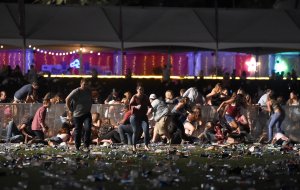After Stephen Paddock opened fire on concertgoers from his perch stories above them, officers cautiously crept up a hallway as they prepared to storm the gunman’s Las Vegas suite.
“Breach. Breach. Breach,” a voice said on a police radio. Then, a loud blast was heard.

Las Vegas police on Wednesday released body camera footage from officers who entered Paddock’s hotel suite on the 32nd floor of the Mandalay Bay Resort and Casino immediately after October’s mass shooting.
The footage showed the moments before officers swarmed the room, where Paddock’s body was discovered. The video also shows police sweeping the premises.
Paddock, 64, killed 58 people and injured almost 500 when he opened fire on 22,000 concertgoers.
One video clip shows that police moved forward after the explosion and waited in a doorway as the hotel’s alarm went off.
“There’s a 413 on the ground,” an officer said, giving the police code for a person with a gun.
Officers approached Paddock’s door, which was blocked by a room service cart. “Looks like it might be a camera of some sort,” one officer said.
Officers noted there were also multiple cameras, according to the footage.
More officers rushed past.
“Hold on, hold on,” another officer said.
As officers entered the suite, they noticed more cameras pointing down the hallway, and that the rooms were connected.
Officers cleared the suite room by room, searching under the bed and in closets with dogs.
911 call audio will also be released.
Sheriff Joe Lombardo of the Las Vegas Metropolitan Police Department said video footage, 911 call audio and documents relating to the October 1 massacre would be released on a rolling basis starting with the body camera footage from two officers.
“I don’t know how this footage will be played in the media, but I want to warn you, if you are a survivor or a family who lost a loved one, you should know the video from this concert is disturbing and graphic,” he said.
Lombardo said he expected the materials would be released weekly but would not say if the information would be posted on a website or emailed to media.
Court ordered release of footage
The Nevada Supreme Court ruled Friday that police had to release the bodycam footage and 911 call audio from the shooting.
Police had appealed an earlier ruling that the material be released, following requests by media, including CNN.
Lombardo denied that police were trying to be uncooperative. In a press briefing Tuesday, he cited cost, allocation of resources and potential further victimization of those affected by the shooting as reasons for delaying the release of footage, recordings and documents.
For example, the department had to reassign detectives from their “primary responsibility” to go over the reports and footage before they were made public, and some personnel would have to endure reliving the shooting, he said.
“I want the community to know the release of the videos, 911 and documents will have a significant impact on the victims of this tragedy. We believe the release of the graphic footage will further traumatize a wounded community,” he said. “And for that, we apologize.”
Lombardo said no employees will be made available for interviews, but said a final comprehensive report on the shooting will come.
Criticism of police
Police were criticized about their response when a timeline suggested there had been a six-minute delay between Paddock shooting a security guard and the gunman opening fire on the crowds below his hotel suite.
The timeline raised questions about why police didn’t arrive on the scene sooner.
“In the public space, the word ‘incompetence’ has been brought forward. And I am absolutely offended with that characterization,” Lombardo said on October 13.
He said that during the six-minute gap, the security guard had been trying to access Paddock’s room — and that he had been shot around the same time the gunman started firing on concertgoers.
“So there is no conspiracy between the FBI, between the (Las Vegas Metropolitan Police Department) and MGM (the hotel owner). Nobody is attempting to hide anything in reference to this investigation,” Lombardo said at the time.
“The dynamics and the size of this investigation requires us to go through voluminous amounts of information in order to draw an accurate picture.”











